1110 Search Results for Core
November 3, 2016
by Carole Zangari -
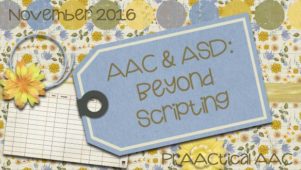
Today, we welcome Dr. Kimberly Ho, SLP and Director of Speech, Language and AAC Services at Confidence Connection in Needham, Massachusetts. In this post, she discusses how professionals in her organization are supporting AAC learners with autism on the journey toward flexible, generative language. I am the Director of Speech, Language and AAC Services at an ABA clinic, so naturally we serve many individuals with Autism Spectrum Disorder (ASD) of all ages. A vast number of learners with ASD can speak, but their speech is not functional to meet their communication needs. We have begun to provide word-based AAC systems for these students to move beyond scripting. Many individuals with ASD “script.” That is, they may not produce novel utterances, but rather chunks of phrases and sometimes entire sentences they have memorized. Sometimes this scripting is based on a character from a TV show or movie. Other times the script has been memorized in... [Read More...]
November 2, 2016
by Carole Zangari -
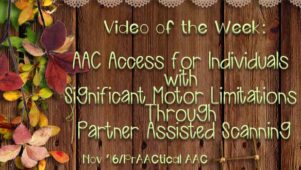
Developing effective communication systems for individuals with significant motor challenges is a challenging process. Ultimately, the goal is to provide them with tools and strategies that allow them to communicate independently and help them develop the skills needed to say what they wish to throughout their daily life experiences. As we all know, this can be a long journey. And while we work toward systems that allow them to communicate independently, they need access to language and communication now despite their motor limitations. Partner assisted scanning (PAS) is one option that works for many AAC learners. In this post, we feature a video overview of this strategy presented by SLP Maureen Nevers as part of the Communication Training Series by the Angelman Syndrome Foundation and the Foster Family Charitable Foundation, and a video of PAS in action by the Dynamic Learning Maps Professional Development (DLM PD) group under the direction... [Read More...]
October 31, 2016
by Carole Zangari -
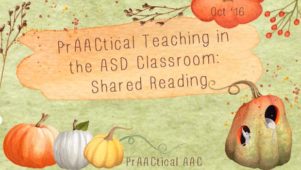
We are pleased to have a return visit from special educators Lauren Pawlowski and Amy Devin with ideas for supporting AAC learners in the classroom. Amy and Lauren, who work in the public school system in Michigan, taught in resource rooms for years and have been teaching in self‐contained ASD elementary classrooms since 2009. At that time, there were few classrooms who were integrating core language instruction, but they didn’t let that stop them. Currently, they use manual communication boards, large instructional core boards, and individual AAC devices with their students. They are passionate literacy teachers and, in today’s post, tell us about their approach to shared reading lessons. Their video is chock full of tips to help you make these lessons successful. Enjoy! Shared Reading: It’s Not What They Know, It’s What They THINK! Happy Fall AAC users and facilitators! This month we would like to share some of our tips for... [Read More...]
October 30, 2016
by Carole Zangari -
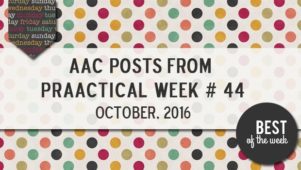
And, just like that, another AAC Awareness Month is a wrap. (Seems like October just flew by!) Hope you had fun spreading the news about AAC options. Here are a few posts you may have missed. Monday: 5 Visual Supports for the AAC Classroom Wednesday: PrAACtically November: Resources for A Year of Core Words Thursday: How We Do It: A Collaborative Approach to Implementing Core Language within a School-Based Setting, Part 1
October 20, 2016
by Carole Zangari -

Shared book reading is a great way to get families involved in building language and AAC skills. Today we’re back with another AT Recipe for Success from SLP Sara Barnhill and the AT Team at Children’s Hospital of Richmond at VCU. They’ve created several extension activities based on the book, Sometimes I Feel Sunny, to help families have fun and build AAC skills at the same time. As a member of the AT Core team, Sara is involved in AAC evaluations and therapy in the hospital’s clinics, out-patient program and Transitional Care Unit. CHoR’s AT Program is one of few comprehensive AT programs in Central Virginia. Their program provides AT evaluations, equipment and training to people of all ages, enabling children and adults with disabilities to function more independently. CHoR’s AT team consists of four SLPs, two OTs, one PT, and one Therapy Practice Assistant. In addition to completing transdiciplinary evaluations and treatments, CHoR’s AT team is... [Read More...]
October 16, 2016
by Carole Zangari -
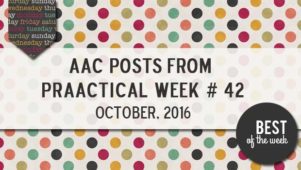
AAC Awareness Month is in full swing! How have you been celebrating? Monday – Site of the Month: Core Word Classroom Wednesday – Video of the Week: Alternate Pencils Friday – “But he doesn’t like anything!” 5 Tools for Identifying Motivators and Reinforcement
October 6, 2016
by Carole Zangari -
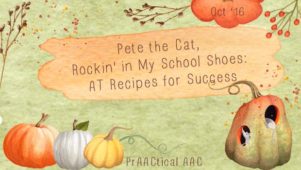
It’s time for another AT Recipe for Success with SLP Sara Barnhill and the AT Team at Children’s Hospital of Richmond at VCU. Today, we’re learning how they use extension activities based on the book, Pete the Cat Rockin’ in My School Shoes, to help families have fun and build AAC skills at the same time. Sara and her colleagues have been incredibly generous in sharing their work over the past several months. If you missed them over the the past few months, you can view previous posts here. Each one has parent handouts for you to download. As a member of the AT Core team, Sara is involved in AAC evaluations and therapy in the hospital’s clinics, out-patient program and Transitional Care Unit. CHoR’s AT Program is one of few comprehensive AT programs in Central Virginia. The program provides AT evaluations, equipment and training to people of all ages, enabling children and adults with disabilities to... [Read More...]
October 4, 2016
by Carole Zangari -
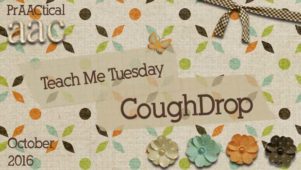
We’re back with another post featuring learning resources about AAC apps, software, and SGDs. This week, we’ll look at CoughDrop, an open source AAC program, and hear from a young clinician who uses it in her work. If you are new to CoughDrop, consider taking a little time to get to know it using the links below. Ready to explore? Here are some resources to get you started. Video overview Links to various versions: iOS app; Android app; Windows 64-bit; Windows 32-bit; Kindle app Video Tutorials Where to go for help: Support Requests; Contact page; Frequently Asked Questions My Experience with CoughDrop by Samantha Cutler Primarily, I’d like to issue a disclaimer that I am in no way affiliated with CoughDrop nor do I receive any financial gain from them. It is merely a program that I enjoy using and I wanted to share my experience with the AAC community. In the... [Read More...]
October 2, 2016
by Carole Zangari -
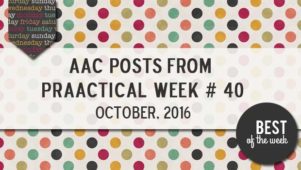
As many of you know, October is AAC Awareness Month, a time when the AAC community comes together to build understanding of complex communication needs in their communities, schools, and workplaces. It’s exciting to see how this movement is growing in every part of the world. If you share news of your events on social media, please tag us (@PrAACticalAAC on Facebook, Instagram, and Twitter) so that we can help you spread the word of your AAC awareness activities. Also, feel free to use the buttons and banners in this post in your own social media profiles or posts. In the meantime, here are links to a few posts you may have missed. Monday: Five Places for Shared AAC Materials Wednesday: Video of the Week: Shared Writing and AAC Thursday: PrAACtically October: A Year of Core Vocabulary Resources Social Media Images (PC users: right click to save image to your computer; Mac users: control... [Read More...]
September 28, 2016
by Carole Zangari -
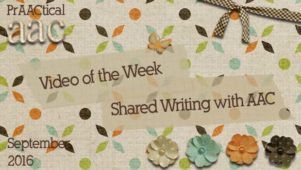
Looking to round out your literacy supports with writing activities? Shared writing using a predictable chart is a great strategy to utilize with students who use AAC because there are so many rich opportunities for learning about print while practicing communication. In this video, SLP and AAC specialist Deanna Wagner describes the process of using core word sentence starters and covers essential elements of implementation. If you are not doing formal writing instruction with AAC learners, this is a great place to start. Direct Link to Video: https://www.youtube.com/watch?v=Ll90gwo5rQQ









